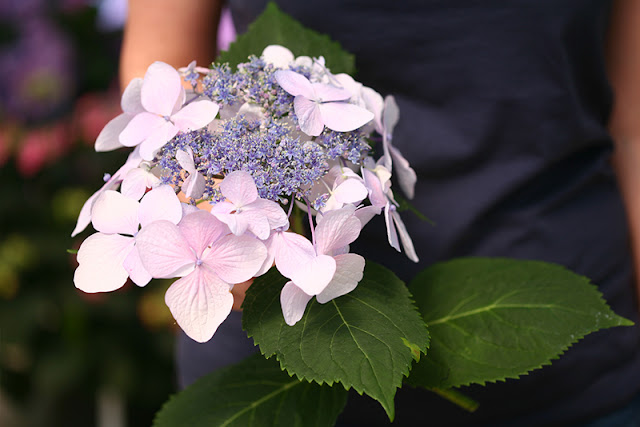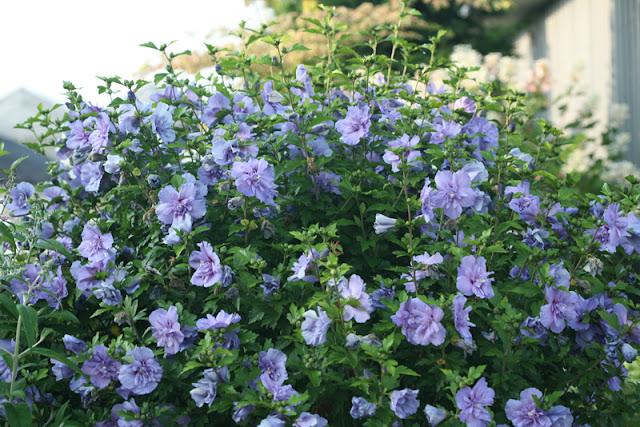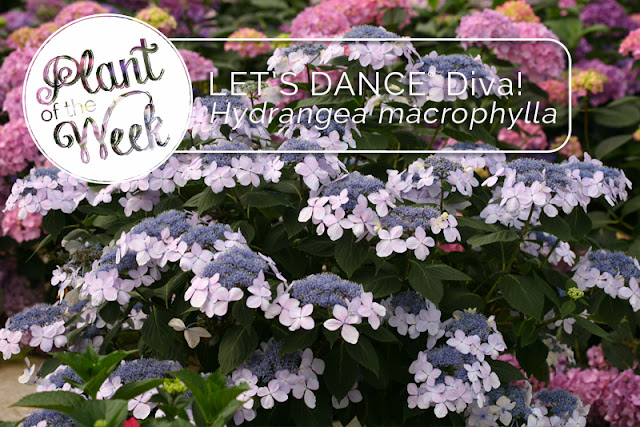Time to watch the ball drop!If you can stay up that late, anyway. I don't think I've stayed up to watch the Times Square Ball Drop since having kids. But I do enjoy this 'Diamond Ball' clematis. Sure, it does its thing in summer, not on New Year's Eve, but I think it's worth the wait.Clematis 'Diamond Ball' flowers on both old wood and new wood, so it's a much easier plant for the average gardener to grow. You will see flowers from June through August. The white-blue flowers are round or semi-spherical in shape and reach 4-5" in diameter. And not to belabor the Pantone colors, but this will be one of the popular colors in the new year. 'Diamond Ball' will grow 5-6' tall and 2-3' wide and is hardy to USDA Zone 4. It grows in full sun or partial shade. Try in a patio container or along a fence. Pruning ClematisThis is a tricky subject. Clematis can be an intimidating group of plants. Until recently, I avoided the subject of when to prune them by simply not growing them. Our new varieties, however, tempted me, and I have them growing in my garden. I took the plunge after learning that pruning these new varieties isn't tricky at all. They bloom on both old and new wood, so I can prune them in the spring with many of my other plants.Older varieties will need more specific culture. Cultivars are placed in one of three groupings, determined by their bloom time, and pruned accordingly. Fine Gardening has a nice overview. Clematis are a great addition to any garden. They add color in unexpected places, like fences, and can even be grown in patio containers with a trellis. I have found that they need a season to get their legs under them before you see a lot of flowers. Once those roots get established, though, get ready for a real flower show! So how about this for a New Year's resolution: grow a new plant. Pick one that has intimidated you in the past (like Clematis). Or maybe one that you've never heard of. Trying a new plant is way more fun than resolving to lose weight or do sit ups every morning. Plant of the Week is written by Jane Beggs-Joles. |
December 31, 2015
Plant of the Week: Clematis 'Diamond Ball'
December 21, 2015
Plant of the Week: Let's Dance Diva! Hydrangea
We're still talking about the 2016 Pantone Color(s) of the Year. After all, they're perfect for hydrangeas - and we do love our hydrangeas here at the nursery. So does the lady behind the color selection process.
This week's top plant is Let's Dance® Diva! reblooming Hydrangea macrophylla (bigleaf hydrangea). This cultivar has exceptionally large lacecap flowers. The colors range from soft pink to soft blue - perfect for next year's color trends! And if you think that gardeners don't like lacecaps, think again. Let's Dance® Diva! hydrangea was our Shrub Madness Champion in 2014.
Let's Dance® Diva! hydrangea grows 3-4' tall and wide and is hardy to USDA Zone 5. It will grow in full sun or partial shade.
 |
| A single bloom of Let's Dance Diva! reblooming hydrangea is larger than a dinner plate. |
Pink or blue?
Hydrangea macrophylla will go either way. Some lean more to blue, while others lean to pink. Pay attention to the cultivar description and plan accordingly because some varieties 'blue' better than others. Let's Dance® Blue Jangles® reblooming hydrangea is one of them. Others are fabulous as pink - see Paraplu® hydrangea. Some are easy to change, like Let's Dance® Rhythmic Blue™ reblooming hydrangea. And others won't get blue no matter how much you treat the soil (we're looking at you, Cityline® Paris hydrangea).Our new Let's Dance® Rave hydrangea is at its best as a unique violet. That will come as a surprise to those who try to avoid the dreaded 'blurple' flower, but we decided that it was a beautiful color. Check it out and see what you think.
In the meantime, here's a refresher on changing the color of your hydrangea flowers. Remember, it's just the H. macrophylla and H. serrata (mountain hydrangea) that will shift color. H. arborescens (smooth hydrangea), H. quercifolia (oakleaf hydrangea), and H. paniculata (panicle hydrangea) flower color will not be affected by soils. Also, it can take a season or two for many varieties to shift colors, so you need to plan ahead if you want blue flowers.
Finally, please take a look at our Hydrangeas Demystified pdf. This is one of our most popular flyers. You are welcome to use it as you educate your readers about this always-popular genus!
 |
| The soft shades of Pantone's Colors of the Year, rose quartz and serenity, are perfectly reflected in Let's Dance Diva! hydrangea's lacecap flowers. |
Plant of the Week is written by Jane Beggs-Joles.
December 14, 2015
Plant of the Week: Chiffon Roses of Sharon - and the Pantone Color(s) of the Year!
The Chiffon™ Hibiscus are strong-growing, uniform varieties. Both varieties grow 8-12' tall and will do best in full sun. They are hardy to USDA Zone 5 and will attract butterflies to gardens while resisting deer browsing. These are easy-to-grow, durable varieties that your readers will have plenty of success with in their landscapes. Bonus: they have a low seed set to limit unwanted seedlings!
Why should you care?
You may be asking yourself that very question. What does the Pantone Color of the Year have to do with gardening?
The famous 'Cerulean blue' monologue from The Devil Wears Prada does an effective job of explaining why you should care. The reasoning extends far beyond clothing: kitchenware, home decor, advertising - they will all be affected by the trending colors. Even gardens will feel Pantone's influence.
Pantone expects the Color of the Year to affect sales for up to three years in the future. That's good news for those of us in the growing business since we need a little time to get the Color of the Year into production. You will also want to revisit the past few years' colors, too, and feature plants with those popular hues.
The famous 'Cerulean blue' monologue from The Devil Wears Prada does an effective job of explaining why you should care. The reasoning extends far beyond clothing: kitchenware, home decor, advertising - they will all be affected by the trending colors. Even gardens will feel Pantone's influence.
Pantone expects the Color of the Year to affect sales for up to three years in the future. That's good news for those of us in the growing business since we need a little time to get the Color of the Year into production. You will also want to revisit the past few years' colors, too, and feature plants with those popular hues.
- In 2015, the Color of the Year was Marsala - ideal for Summer Wine® Physocarpus.
- In 2014, it was Radiant Orchid. Maybe Let's Dance® Rave™ Hydrangea is in order.
- 2013's color was Emerald. So many possibilities...maybe North Pole® Thuja?
 |
| Blue, Lavender, Pink or White: with abundant flowers and a graceful habit, the Chiffon series has become a staff favorite. |
Plant of the Week is written by Jane Beggs-Joles.
December 7, 2015
Plant of the Week: Pearl Glam Beautyberry
Pearl Glam Callicarpa differs from its sister in that it has white flowers; Purple Pearls Callicarpa has distinctive pink blooms. Both plants will have their best foliage color in full sun, grow 4-5' tall and wide, and are hardy to USDA Zone 5. Callicarpa have good deer resistance; I have seen them used quite a bit in areas where there is heavy deer browsing.
 |
| The berry-laden branches of Pearl Glam Callicarpa are ideal for arrangements. |
Landscape plants
All of our plants are landscape plants, of course. We don't produce house plants here at the nursery, but some plants are particularly good for the landscape market. Callicarpa is one of them. It's a trouble-free plant that adds very desirable fall interest to landscapes. Its compact size is useful, too. It may be used in a mixed border or as a foundation plant. For big impact, try it in a mass planting. It tolerates clay soil, too.We're very optimistic about the landscape market for 2016. One reason is that 2016 home sales are expected to be their best since 2006. More houses mean more plants. I love the sound of that! OK, you knew this was coming: those of you who like Pearl Jam can indulge. Those of you who don't, well, I guess you can go back to work.
 |
| Pearl Glam Callicarpa is covered in violet berries in fall. |
Subscribe to:
Posts (Atom)
Featured Post
Plant of the Week: Emerald Envy® Viburnum
Plant of the Week is written by Jane Beggs-Joles The Emerald City is on my mind right now because I'm headed to Seattle this week for ...







